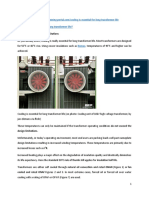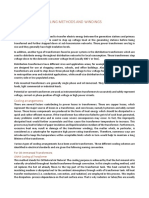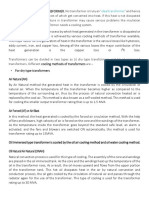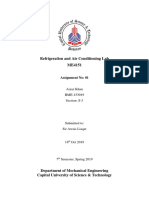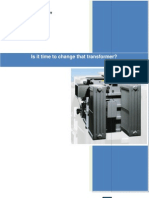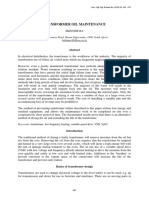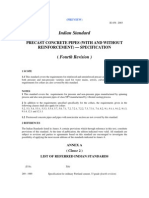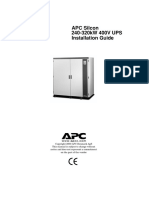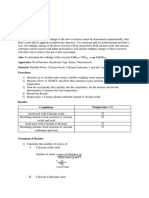The Importance of Proper Cooling of Power Transformers
https://powertransformerhealth.blogspot.com/2019/08/the-importance-of-proper-cooling-of.html
The correct design and operation of the cooling system of a power transformer is very important to
maintain the health of the transformer. The design and type of cooling is usually governed by the
application of the power transformer and is influenced by power output, location and environmental
conditions. The cooling system thus in turn affects the design of the transformer. The primary
purpose of the cooling system is for the efficient removal or transfer of energy created by the
heating effect of losses within the power transformer (components like windings, core and
structures), out into the environment.
The environmental cooling medium is usually air or/and water. The following are the different types
of cooling configurations that may be used in oil filled transformers [1, 2]:
ON Oil Natural
ONAN Oil Natural Air Natural
ONWF Oil Natural Water Forced
OFAN Oil Forced Air Natural
OFAF Oil Forced Air Forced
OFWF Oil Forced Water Forced
ODAN Oil Directed Air Natural
ODAF Oil Directed Air Forced
ODWF Oil Directed Water Forced
Naturally oil cooled method is usually used on smaller rated transformers and generally within 30
MVA, where the heat generated from the core and windings are large enough to allow for natural
convection circulation of oil to cool the transformer. The principle of natural convection arises when
hot oil rises and the cold falls in an enclosed area resulting in organic circulation of oil. The cooling
surface area can be increased by providing the cooling tubes or fins to improve the efficiency of
cooling.
Transformers may also have forced air cooling by means of fans to allow for external air circulation.
As the rating of transformers increase (usually greater than 60 MVA) the internal oil circulation
becomes more of a requirement to allow for quicker transfer and removal of heat generated
allowing the transformer to operate within the designed temperature rise. In this case forced oil
circulation is used by means of oil pumps in the oil flow circuit.
Water cooling is usually used in Hydro plant applications where the transformers are located
underground. The water cooling forms an open loop system with the oil circulation being closed
loop. To prevent contamination of the oil with water the coolers are usually designed with either
double finned or having and intermediate closed loop low pressure water circulation. Leak detection
is usually provided.
�Failure Modes in the Cooling System
Cigre A2.49 [3] has highlighted the following Failure modes for the cooling systems. These are
predominantly due to the wearing out of cooling system components. Other problems may be due
to installation problems especially after maintenance activities. When this happen the two basic
functions of the cooling system i.e. oil circulation and heat exchange are affected.
The failure of cooling fans usually affects the load of the transformer. Usually there are spare fans
but if more than one fan is out of service there may be a need to reduce load so as to maintain the
designed temperature rise of the transformer.
Sometimes when maintenance work is carried out on the coolers it is possible for the fans being
replaced to be connected in the wrong direction resulting in inefficient cooling due to recirculation
of warm air causing elevated oil temperatures.
The failure of cooling pumps is another major problem especially of forced oil systems. This affects
the flow and circulation of oil in the transformer windings and core resulting in ineffective heat
transfer to the external environment. Pump failure usually results in elevated oil temperatures.
Again it can happen that after maintenance work pumps are connected in the wrong direction
resulting in reduced heat transfer efficiency which affects the general cooling of the transformer.
Failure of the control circuit of the cooling system plays can affect the operation of the cooling
systems where insufficient fans and pumps from the coolers are activated for the relevant loading.
This will cause elevated oil temperatures.
�In cooler radiators high level of particles and sludge formation may block cooling ducts, piping and
flow paths. This affects the oil flow and which reduces the cooling efficiency. Oil-water heat
exchangers can also be blocked on the water side due to deposits or corrosion causing decreased
cooling efficiency.
Another common problem is when radiator valves are left in the closed position. This prevents oil
from circulating within the radiators causing major heating within the transformer.
The low viscosity of oil can also affect oil movement in the convection process especially through
the winding cooling ducts. The viscosity of oil is affected by dissolved particles and oil ageing by-
products and is dependent on oil temperature.
Leaks are a significant problem in cooling systems usually at the interface points to the tank and
ancillary components. These may be due to the effects of corrosion or aging of the insulation
material like gaskets.
With the changing environmental conditions becoming more prevalent, elevated ambient
temperatures may affect the heat transfer from the transformer to the environment. This is also a
major problem with transformers located in enclosed areas (buildings) when the HVAC system fails.
Also, very low temperatures (at zero degrees Celsius or below) can affect water cooling where the
water can freeze.
Sometimes, in summer months, high inlet cooling water temperature can affect the cooling
capability of the coolers. This may occurs if the transformer was not properly designed for the
environmental conditions.
Inspections and Maintenance
It is very important have an intense inspection and maintenance program to identify failures
beforehand so that these can be proactively resolved without affecting the performance.
Infrared scanning is an important and simple tool that can be used to provide a relative difference in
surface temperature enabling areas of elevated temperature to be easily identified. Infrared
scanning is usually done when the transformer is on load. It is usually most effective when done on a
transformer that has been returned to service where problems like a closed radiator valve being left
closed.
Temperature monitoring is a standard monitoring that is provided on most transformers. The prime
purpose is to measure the energy within the transformer and any abnormal conditions can be easily
picked up especially with regards to the cooling system as it easily affects the average temperature
of the transformer. The top oil temperature is usually represents the inlet temperature of the
coolers and when compared to the outlet temperature a differential can be established. This can
then be compared between coolers.
Cigre Working group A2.27 recommendations for Condition Monitoring Facilities recommended that
the following temperatures should be available for condition monitoring [4]:
Top oil – measure of the temperature of the oil at the top of the tank
Bottom oil – measure of the temperature representing oil entering the bottom of the windings
usually the cooler outlet temperature
Cooler inlet oil – can be taken same as Top oil temperature
Cooler outlet oil – measurement taken from the cooler outlet oil. In some transformer designs
the bottom oil measurement can be used.
� Cooling medium at inlet to coolers – a measurement representative of the temperature of the
cooling medium (normally air or water) at the inlet to the coolers. In the case of an air
temperature measurement, the sensor should be mounted in the shade. Air ambient temperature
can be used if this measurement is not available. For water cooling medium a sensor or
thermometer pocket should be included at both the cooler inlet and outlet.
Ambient temperature – Monitor the ambient temperature if the transformer is located in an
enclosed area (building). This temperature must be alarmed for immediate investigation when the
alarm value is triggered.
The Cooler Performance Index: Temp (Inlet – Outlet) can then be derived by finding the
difference between the Inlet and Outlet temperatures. The difference (delta) can then be
compared between coolers or designed values, if available. Temperature deltas more than 30%
of between coolers should be investigated further.
Oil flow is another important monitoring parameter. Forced oil (OF, OD) cooling systems have
designed flow rates to provide the accepted temperature rise. Modern transformers usually have oil
flow indicators or switches confirming oil flow. Analogue oil flow meters provide actual flow rates
which can be trended. These can also be compared between coolers and any flow anomalies can be
easily identified. Oil flow provided pumps can be compared with about 80% of oil pump nameplate
or in pump manual (considering 20% oil flow reduction due to oil path hydraulic resistance).
Routine visual inspection of the transformer oil-cooling loop components should be performed as
regularly as prudent but should not exceed 12 month frequency. All abnormal conditions must be
rectified as soon as possible. This can be a non-expensive way of proactively picking up problems.
Fans must routinely energised to verify proper operation, especially standby fans.
Sludge building up especially on older transformers can affect the flow of oil in the windings and
piping. This must be monitored routinely by doing oil tests such as colour/appearance, acidity,
dielectric dissipation factor (DDF), acidity and interfacial tension (IFT), which can provide indications
of sludge components before visible sludge occurs.
For further information on work related to power transformer health refer to link:
https://powertransformerhealth.blogspot.com/
References
1. IEC 60076-2 Power transformers - Part 2: Temperature rise for liquid-immersed
transformers
2. C57.12.00-2015 General Requirements for Liquid-Immersed Distribution, Power, and
Regulating Transformers
3. Cigre WG A2.49 Condition Assessment of Power Transformers
4. CIGRE, Technical Recommendations for Condition Monitoring and Condition Assessment
Brochure 343 Facilities for Transformers

